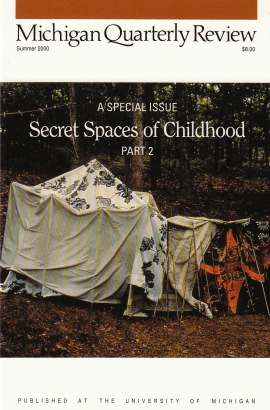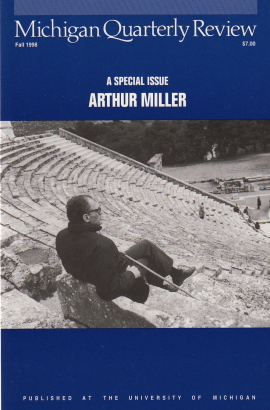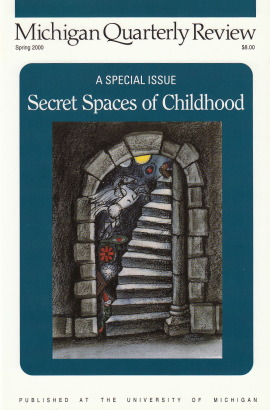Secret Spaces of Childhood, Vol. II
Edited by Elizabeth Goodenough
The issue is dominated by a symposium of some thirty writers from different fields responding to a question about the most memorable secret space of their own childhoods. Their mini-essays are not only descriptive but analytical, as they reflect on the state of childhood itself, in personal experiences, in texts, in modern culture. Ranging from a long paragraph to several pages, these commentaries provide an iconography of the state of childhood that will interest scholars of the field as well as general readers.
Nonfiction: Among the authors are Wayne Booth, Paul Brodeur, Jim Harrison, Philip Levine, Valerie Miner, Robin Moore, Joyce Carol Oates, Paul Roazen, Tobin Siebers, Ellen Handler Spitz, Lore Segal, Robyn Sarah, David Shields, Ilan Stavans, John R. Stilgoe, Marina Warner, Paul West, and Edward O. Wilson. Several long essays featured include works by Joan W. Blos who considers the importance of diaries to children, using as examples Anne Frank, Louisa May Alcott, and the fictional diarist of her own Newbery Award-winning novel. Mary Galbraith shows how the author of the children’s classic Madeline drew upon his own childhood traumas in forming the narrative of his world famous tale. Sandra M. Gilbert writes a self-reflective essay on the way she has imagined the secret spaces of childhood in her own poems, and how a retrospective analysis makes the poem’s meanings clearer even to her. Margaret Morganroth Gullette isolates for inspection one kind of childhood experience common to everyone: the exploration by a group of friends of some strange and forbidden territory beyond the safe perimeter allowed by parents. Jeanne Schinto contributes a long essay that begins with a description of her enraptured visits as a girl to a local natural history museum, and opens up into a consideration of museums in general as nourishers of the childhood imagination, with some commentary on whether contemporary museums are fulfilling their mission. John Taylor, a fiction writer and essayist living in France, visits the hometown of Alain-Fournier, author of the 20th-century classic of adolescent experience, Le Grand Meaulnes (translated into English both as The Lost Domain and The Wanderer), and describes the persistence of Fournier’s visionary world as an authentic place.
Fiction: Abdon Ubidia‘s magical story about a boy who mimics animal sounds is unforgettable; Wanda Coleman contributes a story about a mother and her children in South-Central Los Angeles; novelist Catherine Ryan Hyde, too, uses Los Angeles as the backdrop for a moving story about a boy seeking solace after his father is criminally attacked.
Poetry: Sarah Hannah Goldstein, Alison Eir Jenks, James Nolan, Suzanne Rhodenbaugh, Virgil Suarez, and Ann Townsend.
Reviews: Karein Goertz considers the life and diary of Anne Frank in the Secret Annex as a paradigm of modern childhood; Kenneth Kidd discusses the material culture of girls and boys; June Cummins and Nicholas Tucker analyze the astonishing appeal of Harry Potter.



